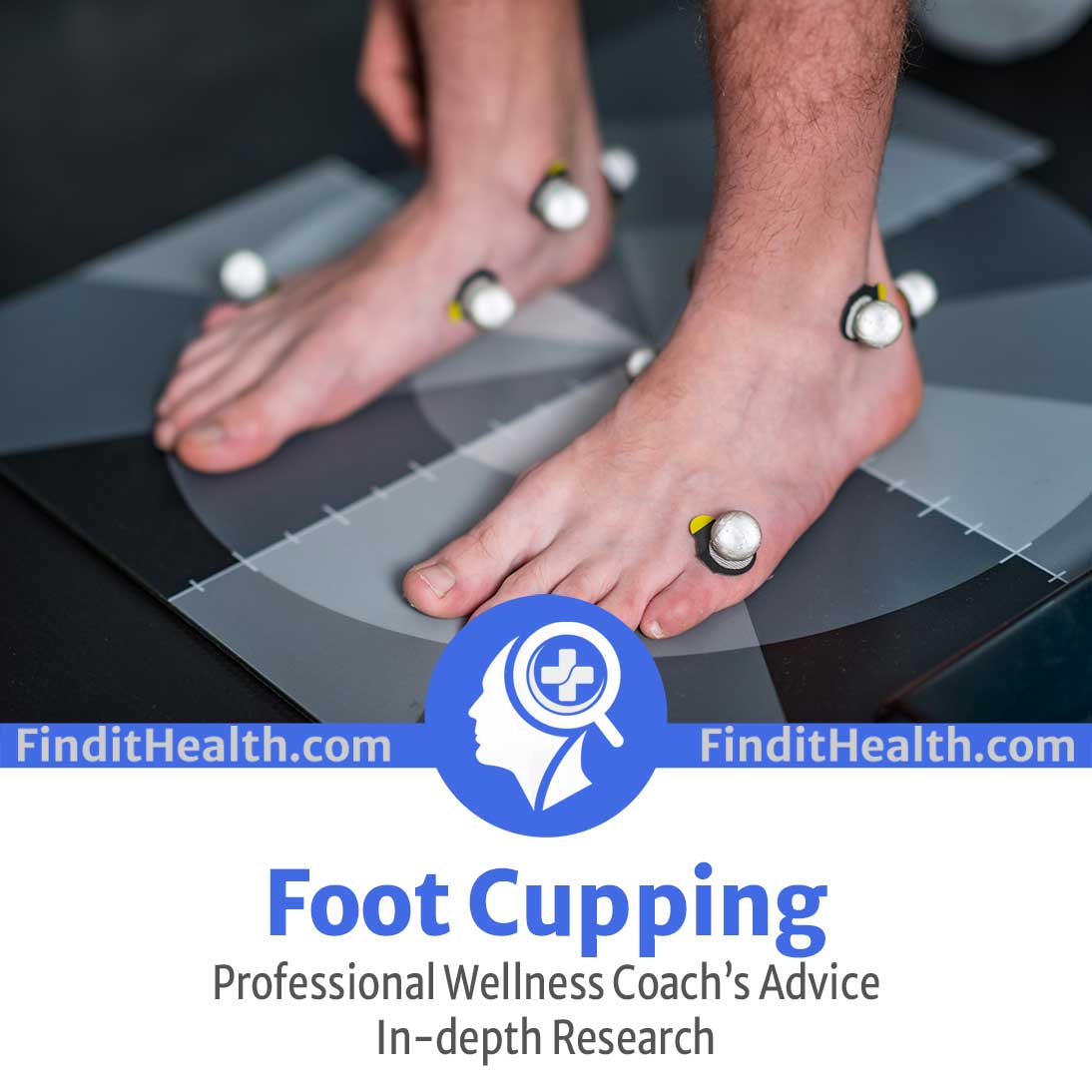
As the director of the wellness team here at Find It Health, I would like to introduce you to an ancient healing technique with modern applications: foot cupping.
The process involves placing cups on the feet and creating suction to draw up the underlying tissues. This, in turn, stimulates blood flow and helps loosen tight muscles, leaving your feet feeling relaxed.
In this article, we will explore in detail the foot cupping process, what it can do for you, and how to use it safely.
Foot Cupping Benefits
The ancient practice of foot cupping has several practical benefits, which include the following:
Promotes Blood Circulation
Foot cupping increases circulation in the feet by widening blood vessels and allowing for more oxygen-rich blood to reach the tissue. This helps reduce pain, inflammation, and stiffness caused by poor circulation.
Increases Relaxation
Another benefit of foot cupping is that it can help you relax. The suction and massage effect of the cups makes your muscles loosen up and allows you to relax fully.
Promotes Detoxification
Foot cupping helps stimulate the lymphatic system, which is responsible for keeping toxins from accumulating in our bodies. Not only does this help reduce toxin buildup, but it also helps flush out metabolic waste.
Has a Positive Effect on Mood and Mental Well-being
Many people report feeling calmer and more relaxed after having the therapy done. This is because the massage stimulates nerve endings in the feet, positively affecting our brain chemistry.
In addition, the feeling of warmth and pressure helps us feel relaxed and helps reduce feelings of stress and anxiety.
Improves Range of Motion
Foot cupping also helps improve the range of motion in our feet and ankles. This can help with conditions like plantar fasciitis and other foot injuries that limit mobility.
The massage also increases blood flow to the area, which helps reduce stiffness and soreness in muscles.
Improves Energy Flow
The massage helps unblock energy pathways in our body, which helps regulate the flow of vital energy throughout the body. This can help us feel more energized and alert during the day.
Additionally, it can also improve our sleep quality at night.
Relief from Aches and Pains
Foot cupping is an effective way to treat chronic and acute pains in the feet. It helps to reduce inflammation, improve circulation to the area, and alleviate pain quickly.
This can be especially helpful for those who suffer from aching feet after long days of standing or walking.
SUBSCRIBE for FREE STRESS MANAGEMENT TECHNIQUES from our EXPERT COACHES!
Foot Cupping Risks
Foot cupping is generally considered a safe practice when performed by a trained practitioner. However, it can pose some risks and side effects when not correctly performed.
Here are some of them:
Bruising and Skin Irritation
Foot cupping may leave bruises and red or purple marks on the skin, which may take weeks to fade. In some cases, it may cause skin irritation and blisters.
Infection
If the cups are not properly sterilized or if the skin is broken, there is a risk of infection.
Blood clots
Foot cupping may dislodge blood clots and increase the risk of deep vein thrombosis in some people. If you have a blood clotting disorder or are on blood thinning medication, consult your doctor before trying foot cupping.
Burns
If the cups are left on for too long, it may cause burns on the skin. Proper monitoring and training are essential to avoid this risk.
Dizziness and Lightheadedness
Foot cupping may cause a drop in blood pressure, resulting in dizziness or lightheadedness. Getting up slowly after a foot cupping session is essential to avoid this side effect.
May Lead to Nausea, Vomiting or Fainting
Some people may experience adverse effects such as nausea, vomiting, or fainting during or after a foot cupping session.
This is more likely to occur in people with low blood pressure or other pre-existing health conditions. If you experience any adverse effects, stop the session immediately and seek medical attention.
SUBSCRIBE for FREE STRESS MANAGEMENT TECHNIQUES from our EXPERT COACHES!
Cupping For Plantar Fasciitis
One of the most common applications of foot cupping is for plantar fasciitis. Plantar fasciitis is inflammation of the thick band of tissue that runs across the bottom of your foot and connects your heel bone to your toes.
Foot cupping helps reduce inflammation and break up scar tissue in the plantar fascia, providing relief from the stabbing pain associated with this condition.
For plantar fasciitis, it is recommended to place the cups on the heel and arch of the foot, where the pain is most intense.
This helps draw inflammation away from the affected area and promotes healing. However, multiple sessions may be required to reduce pain and improve mobility significantly.
Does Dry Cupping Work For Plantar Fasciitis?
Dry cupping can be effective in relieving plantar fasciitis pain. Our research team here at Find It Health has found that dry cupping therapy increases blood flow to the feet and reduces inflammation, which helps break up scar tissue and ease pain from plantar fasciitis.
The suction from the cups helps draw inflammation away from the inflamed area in the foot, promoting healing and pain relief. While more research is needed, dry cupping is a promising treatment for reducing plantar fasciitis pain.
For persistent or chronic plantar fasciitis, combining dry cupping with other treatments such as massage therapy, stretching exercises, icing, and orthotics is best.
This helps provide more comprehensive relief and minimizes the likelihood of recurrence.
SUBSCRIBE for FREE STRESS MANAGEMENT TECHNIQUES from our EXPERT COACHES!
Cupping Points For Plantar Fasciitis
For plantar fasciitis, cupping is usually performed on the heel and arch of the foot. The cups should be placed in a circular pattern on the sole of the foot, starting at the heel and extending out to the midfoot.
The cups should be placed approximately one inch apart, and the practitioner can use various techniques, such as massage cupping or dynamic cupping, to promote healing.
The cupping session should last for at least 10 minutes and be repeated several times a week until the pain and inflammation reduce.
Cupping For Foot Pain: Does It Work?
Scientific evidence on the effectiveness of foot cupping is still limited, but some studies have shown promising results.
A small study published in the Journal of Traditional Chinese Medicine in 2017 found that foot cupping was able to help reduce pain and improve function in patients with plantar fasciitis.
Another study published in Evidence-Based Complementary and Alternative Medicine in 2011 found that cupping therapy was able to help relieve pain in patients with fibromyalgia, a condition that causes widespread pain and tenderness.
The exact mechanism behind how cupping therapy works is still under research, but it is already proven that foot cupping helps boost circulation, reduce inflammation, and stimulate relaxation.
The suction created by the cups may also help to release tight muscles and fascia in the feet, helping to relieve pain. While foot cupping may not be a magic cure for all types of foot pain, it can be a helpful complementary therapy for some people.
As with any alternative therapy, it is important to consult a healthcare professional before trying it out, especially if you have any underlying medical conditions or are taking any medications.
SUBSCRIBE for FREE STRESS MANAGEMENT TECHNIQUES from our EXPERT COACHES!
Frequently Asked Questions
What does cupping do for your feet?
Cupping therapy can help to reduce inflammation, break up scar tissue, and boost blood circulation in the feet. It may also provide relief from pain associated with conditions such as plantar fasciitis, fibromyalgia, and other foot ailments.
How long do you leave cups on your feet?
Cups are left in place for about 5-10 minutes, though some practitioners can leave them on for up to 20 minutes.
It’s important to note that this can vary depending on the sensitivity of the skin and the level of suction used, so it is best to work with a trained practitioner who can adjust the treatment to meet your specific needs.
Does cupping heal plantar fasciitis?
Cupping can be effective in relieving plantar fasciitis pain. It helps draw inflammation away from the affected area and promotes healing.
It is best to combine cupping with other treatments, such as massage therapy, stretching exercises, icing, and orthotics, for more comprehensive relief.
How does cupping treat the deep muscles of the foot?
The cups are placed directly on the skin, and the suction draws the skin, muscles, and connective tissue upward inside the cup. This helps to break up adhesions, release tension, and increase blood flow to the area.
The suction intensity can also be adjusted to target deep muscle layers beneath the skin. This allows practitioners to reach muscles that are inaccessible with other treatments.
SUBSCRIBE for FREE STRESS MANAGEMENT TECHNIQUES from our EXPERT COACHES!
Conclusion
Foot cupping is a safe and effective therapy for treating your feet. It can target deep muscles that are not easily accessible with other treatments, helping to reduce pain and promote healing.
With regular sessions, the effects of foot cupping can be long-lasting and provide more comprehensive relief. Whether you are experiencing minor aches or severe pain, foot cupping can provide the necessary treatment to reduce symptoms and improve foot health.
If you think you may benefit from foot cupping, speak to your healthcare provider to see if it is the right fit for you. With the proper use of cupping techniques and consistent practice, your feet will surely get better and healthier.
SUBSCRIBE for FREE STRESS MANAGEMENT TECHNIQUES from our EXPERT COACHES!

